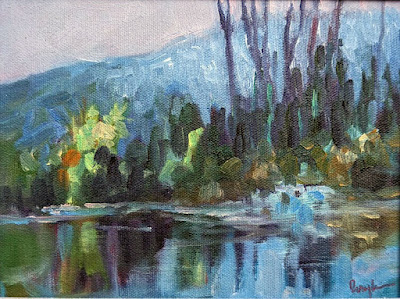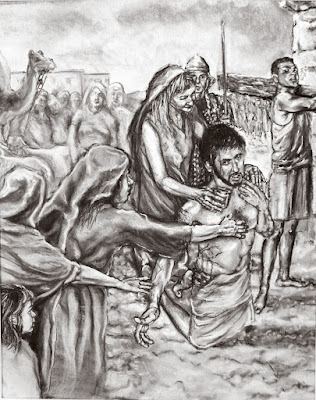Change is hard. Embrace it.
 |
| At the End of the Rainbow, oil on canvasboard, 16X20, $2029 framed. |
This weekend, I received a frame back from a gallery, unwrapped, battered and bruised. Some galleries treat artists’ work with shocking disrespect, so there’s no news there. However, it’s a large, expensive frame and there’s coffee splattered all over the linen fillet, as if it was stood in a corner during a party for the other, more popular paintings. That just adds insult to injury.
“What’s the point of galleries, anyway?” I grumbled. That’s a question I’m asking myself more and more. The internet and COVID have expedited shifts in the art market that are, I’m afraid, permanent. I can either roll with them or whine that everything is changing.
 |
| The Late Bus, oil on canvasboard, $435 framed. |
Rage, rage against the dying of the light, is a line by Dylan Thomas that was part of every schoolchild’s repertoire in my youth. Along with Invictus, it was just about the worst advice ever.
The truth threads a narrow line between those two poems. We’re not the masters of our own fate, and raging against change is a fatal misdirection of our energy.
Meanwhile I need that painting for a show that I’m hanging this weekend. I’ve taken the frame apart, sprayed the fillet with hydrogen peroxide, and will start the laborious business of repairing the corners this morning, if it’s possible.
 |
| Red bud and Red Osier, oil on canvasboard, 12X16, $1449 framed. |
Nobody knows the trouble I’ve seen is one of the great lies we all labor under. Many people get stuck in it. Sadly, the troubles we’ve seen—disrespect, death, abandonment, duplicity, hypocrisy—are horribly common.
“But you don’t understand!” the soul cries out. “It’s worse because it’s happening to me!”
We humans love to discuss our injuries, hurts and losses. We take them out, caress and feed them, and then wonder why they grow. We especially like to convert our hurt into anger, because grief is enervating and anger at least feels alive.
 |
| Best Buds, 11X14, $1087 framed. |
I had a potential exposure to COVID and have to quarantine until tested. I’m vaccinated and unlikely to get sick (although I can be a carrier), so it’s an inconvenience and I’m getting the test as a courtesy to others. That’s something to be profoundly grateful for, because until very recently, the potential implications were far more dire. COVID has hit me hard and personal, so I know of what I speak.
“I’m so mad at anti-vaxxers,” a family member texted. What’s the point, I asked. Anger just sows division. And if and when we ever get around to solving our soul problems, it adds another layer that must be unpicked.
Meanwhile, I chatted with the charming lady who sold us our new dishwasher and stove. “You already know this,” she said, “but every place is having trouble getting good help these days. I’m working six days a week because I’m the only person in this department.”
On Monday, I made oatmeal on a borrowed hot plate. “Do. Not. Talk. To. Me,” I told Doug and the dog, because I had to concentrate. By Tuesday, the hot plate and I were old friends. Change is hard, but we have no choice but to embrace it.


























